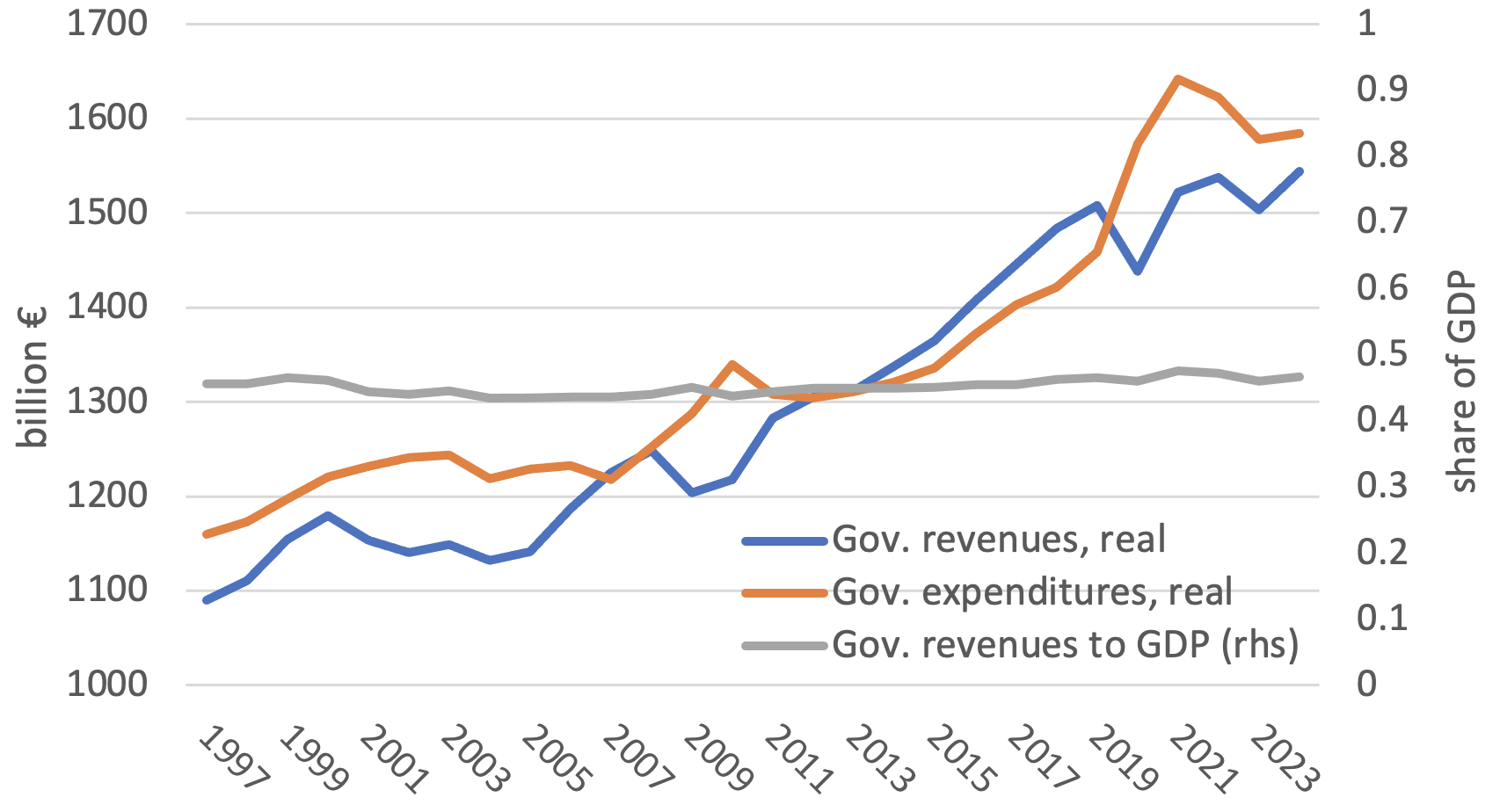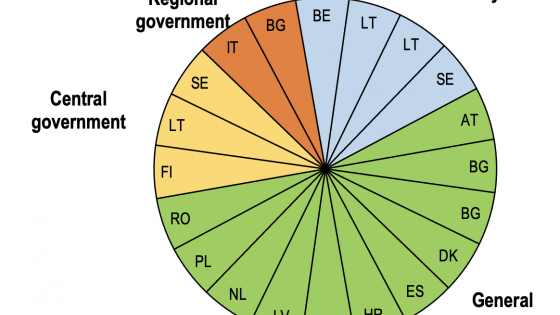From planet Earth we see only one side of the moon because our celestial companion rotates on its axis at the same rate as it orbits earth; the far side remains hidden to us. In the ongoing debate about the EU’s future fiscal framework, the expenditure benchmark – the prospective linchpin of a reformed system – is a bit like that. It has been lit up intensely over the past several years, but have we explored all sides of this wunderkind among fiscal rules?
The dominant narrative underlines a number of important advantages of expenditure benchmarks.
First and foremost, they are predicated on the sound and intuitive notion that public finances will normally stay on a sustainable path as long as government expenditures do not outpace the aggregate level of economic activity in the medium to long run – the governments’ ultimate tax base. In practice, this notion is made operational by relying on estimates of potential output growth as speed limits. Although unobservable, estimates of potential output growth are surrounded by a lower degree of uncertainty than the output gap, the unobserved and fickle ‘fellow’ that has frustrated fiscal policy makers since it appeared on the stage of EU fiscal surveillance in 2005 (Valla and Cohen-Setton 2010, Darvas 2015).
Second, unlike the budget balance or government debt, expenditure benchmarks cover the budgetary aggregate, which, for its most part, is directly controlled by national authorities. With very few exceptions, such as unemployment benefits, the bulk of public expenditure is discretionary and a priori unresponsive to changes in the macroeconomic environment; it is fixed by law. Policymakers may very well decide to curb or increase expenditures for economic or political reasons, but those are deliberate choices requiring the agreement of national legislators. In short, while revenues follow the economic cycle, there is very little automaticity in the evolution of expenditure; governments are bound to implement plans adopted by their parliaments. Hence, what better yardstick to assess the track record of fiscal policymakers? Once an expenditure path has been set, deviations from that path must be the responsibility of national authorities, period.
The third major upside of expenditure benchmarks are their stabilising properties. Staying an agreed course of government expenditures over the business cycle dampens its amplitude as wind and shortfalls of government revenues are absorbed by a country’s fiscal position: it improves in good times and worsens in bad times. In other words, an expenditure benchmark evades the pro-cyclical drift of rules centred on the budget balance or debt.
In light of such clear upsides, can there be any downsides that may change the overall appreciation of the expenditure benchmark as single operational rule of a reformed EU fiscal framework? The answer is yes. There is one aspect the reform debate has left in the dark, and, if unaddressed, may soon entail a dismal compliance record and a premature disenchantment. In this column, we use the latest update of the compliance tracker of the Secretariat of the European Fiscal Board (EFB) to throw light on this point and highlights ways to overcome the issue.
Tying expenditure to economic growth, but at what level?
Expenditure benchmarks are not new to the EU fiscal framework. The global financial crisis of 2008 came with the painful realisation that existing rules and metrics, including the cyclically adjusted budget balance, had not prevented the build-up of major fiscal imbalances which, once reversed, contributed to the unprecedented depth and severity of the crisis. As a result, in 2011 EU policymakers decided to introduce a new rule that would tie expenditure plans to a more stable estimate of the underlying trend of economic activity. In practice this was achieved by capping expenditure growth at or below a ten-year, backward- and forward-looking average of potential output growth.
Experience with the EU’s expenditure benchmark has been mixed so far, not necessarily because the rule did not live up to expectations. Its main advantages did not come to fruition because it was added to existing rules, and the parallel use led to cherry picking, i.e. those in charge of implementing EU fiscal surveillance picked the indicator painting a more benign (or less negative) picture of a country’s fiscal performance vis-à-vis the recommended adjustment (European Fiscal Board 2019).
The European Commission's reform proposal of 26 April 2023 is meant to overcome this predicament (European Commission 2023). If member states agree to the reform, the multitude of fiscal rules in the current version of the Stability and Growth Pact (SGP) would be replaced by a single operational rule, the expenditure benchmark. This change is rightly presented as a major simplification of a system that has grown so complex over the years that fewer than a handful of insiders understand all its ramifications. Once the update is agreed and implemented, nothing will stand in the way of the expenditure benchmark playing out its superiority, as portrayed by the dominant narrative.
Unfortunately, there is one trait that receives little attention in the ongoing debate. This is all the more surprising as the underlying problem is well known and already visible in the implementation of the current SGP. Although built around the idea of sustainable rates of expenditure growth, the expenditure benchmark cannot ignore the problem of picking the right level of expenditures compared to revenues. Hence, public finances can be on an unsustainable course, even if expenditures increase at the same rate as or somewhat below potential output. Figure 1 illustrates the issue using France and Germany as examples of two broader and polar groups of countries in the EU.
In the aftermath of major economic shocks, such as the burst of the ICT bubble in 2001 or the global financial crisis in 2008, most governments typically keep their expenditure plans unchanged or temporarily add new ones in an attempt to stabilise the economy. As a result, expenditures may continue to expand at a rate that is considered to be the underlying speed of real GDP – the government’s aggregate tax base. The crux, however, is that major downturns produce scarring effects: economic growth may return to pre-crisis rates, but levels do generally not recover (Blanchard et al. 2015 and, more recently, Drehmann et al. 2022, Larch et al. 2022). And unless government expenditures are adjusted downward, keeping their rate of growth aligned with potential output turns a fiscal strategy aimed at stabilising output into one that raises questions of sustainability.
Figure 1 General government expenditure and revenue trends
a) France
b) Germany
Source: European Commission
France is a particularly clear case in point. Abstracting from minor year-on-year fluctuations, the country’s government expenditures – measured in real terms – have followed a pretty stable, almost linear upward trend. Government expenditures stayed the course when revenues tanked in the wake of a downturn. The fact that revenues did not return to pre-crisis levels left policy makers unperturbed, repeatedly so. The result is a growing budget deficit and growing debt.
In the short run, Germany’s strategy does not differ from the one of France. After major economic shocks, fiscal policy leans against the wind by keeping expenditures in line with pre-crisis trends or increasing them. However, as economic output and, by extension, government revenues do not recover in the medium term, expenditure levels are adjusted towards, and eventually below the new revenue trend, so as to create buffers for the next shock.
These diverging models of fiscal policymaking clearly emerge from our compliance tracker and from public finances data more generally. In the seven-year periods following (i) the burst of the ICT bubble (2001-2007) and (ii) the global financial crisis (2008-2009), France accumulated a gap between expenditure and revenues of on average close to 30% of GDP, as opposed to 13% of GDP in Germany.
Policy conclusions
In the current debate on how to reform the SGP, most stakeholders are convinced that a new framework built around an expenditure benchmark as single operational rule combined with a greater focus on medium-term outcomes will be much more effective. One key argument put forward in support of this view is that the reformed system would no longer rely on real-time estimates of potential output and the output gap, unobservable variables that have clouded surveillance until now. Relying on ‘more observable’ or ‘less volatile’ benchmarks and looking beyond the short term is considered to be superior.
While one may understand the political appeal of such a narrative, it is predicated on a basic fallacy. Any serious fiscal framework needs to address a fundamental question: what is the underlying path of economic activity from which governments can draw revenues to sustainably finance expenditure in the medium and long term? Under the current SGP, the question is addressed by estimating potential output and the output gap in real time with a commonly agreed method, which in turn is used to form a view of the structural budget balance.
In the ongoing reform debate the question is dodged, but the underlying issue does not go away simply because we do not shine light on it. Government expenditures are only sustainable if aligned with revenues in the medium and long term, and to assess the latter one needs an assessment of both the level and the growth rate of potential output, whether you like the imponderables involved or not. Intense discussions are bound to erupt between individual member states, the European Commission, and the Council on whether a given starting level of expenditure, to be increased at an agreed benchmark rate, would be too high or too low. It stands to reason that without a commonly agreed method, these discussions would seriously jeopardise the effectiveness of the new system.
The fallout of ignoring the far side of the expenditure benchmark would be compounded by the intention to strengthen the medium-term orientation of the fiscal framework. Instead of fretting about year-on-year changes, the argument goes, it is better to pass a final judgement after four to seven years. The obvious risk is that member states who insist on starting from too high an expenditure level will see their imbalances accumulate over time even if they religiously stick to the expenditure benchmark.
To be clear, all this is not to question the Commission’s reform proposal as such. On the contrary, the proposal includes sound ideas. However, they will not come to fruition if crucial elements, which some will shrug off as ‘technical details’, are ignored. Fortunately, there is an easy fix to the problem highlighted in this piece, namely safety margins. The margin would consist in capping expenditure growth at a rate sufficiently below the one assumed to achieve a desired or required debt reduction; and the size of the margin could be linked to past compliance performance. Real-life examples of such safety margins are the ‘Zalm rule’ in the Netherlands – named after a former Finance minister – and an analogous approach followed by the UK treasury in the 1980s. In both cases, authorities anchor(ed) expenditure growth to macroeconomic projections which already incorporate(d) downside risks. The obvious objective of such an approach is to increase the likelihood of attaining fiscal targets in an uncertain world.
Authors’ note: The views expressed in this column are those of the authors and do not necessarily reflect those of the European Fiscal Board or the European Commission.
References
Blanchard, O J, E Cerutti, and L H Summers (2015), “Inflation and Activity − Two Explorations and their Monetary Policy Implications”, IMF Working Paper WP/15/230.
Darvas, Z (2015), “Mind the gap (and its revision)!”, Bruegel blog post, 20 May.
European Commission (2019), “Vade mecum on the Stability and Growth Pact”, European Economy Institutional Paper No. 101.
European Commission (2023), "New economic governance rules fit for the future", proposal for a regulation.
European Fiscal Board (2019), “Assessment of EU fiscal rules with a focus on the six and two-pack legislation”.
Drehmann, M, M Juselius, D Aikman, and X Xing (2022), “The scarring effects of deep contractions”, BIS Working Papers No 1043.
Larch, M, P Claeys and W van der Wielen (2022), “The scarring effects of major economic downturns: The role of fiscal policy and government investment”, EIB Economics Working Paper 2022/1.
Marinhero, C F (2021), “The Expenditure Benchmark: Complex and Unsuitable for Independent Fiscal Institutions”, Comparative Economic Studies 63: 411-431
Valla, N and J Cohen-Setton (2010) “Unnoticed potential output revisions and their impact on the ‘stimulus/austerity debate’”, VoxEU.org, 17 August.
Wyplosz, C (2023), “The European Commission’s expenditure benchmark”, CEPR Policy Insight No. 121.





